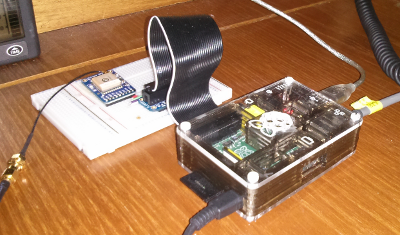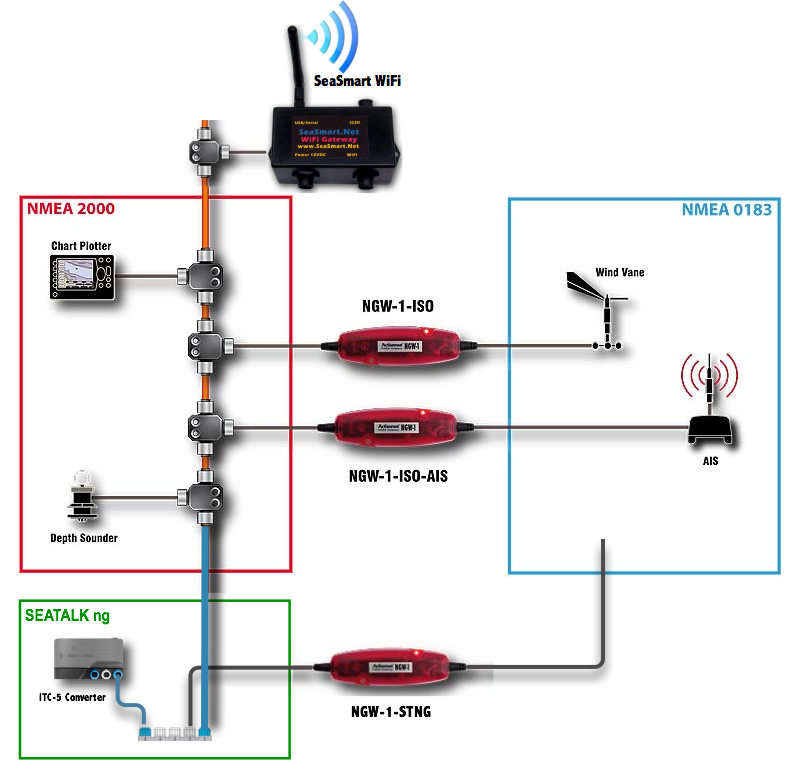

In addition to the data wire, there is also a +12V wire and a ground wire. Each device listens on the data line and is allowed to transmit its data when there is a long enough pause in the communication from other devices. In SeaTalk 1, the devices are daisy-chained, so that data flows from one device to the next in a chain. SeaTalk-NG is a proprietary extension of NMEA 2000. There have been later versions of the protocol with different wiring, the latest of which is SeaTalk-HS.
#Nmea 0813 to nmea 2000 wiring serial
SeaTalk 1 is a proprietary network designed by Raymarine, which is a serial data protocol similar to NMEA, but there is only one "Data" wire and the information flows in both directions along the wire. (Device 1 should ignore it's own messages, but some devices will get confused when receiving their own messages, so the connection into Device 1 may have to be removed.) However, if Device 2 is acting as a "multiplexer" then the output of Device 1 will be combined with the output from Device 2 and sent to Device 3.

you could not connect the outputs from Device 1 and Device 2 directly to Device 3. Note that without using a "multiplexer" there should only be one transmitter going into a NMEA input. There are four wires - data going out of a device is transmitted on one pair and data is received along another pair, there is also a ground (earth) wire. To put this into simple English, each device on the NMEA network can transmit and/or receive data along twisted pairs of wires.

For example, the GPRMC sentence contains Latitude, Longitude, Speed Over the Ground and Track direction. The NMEA 0183 standard defines the contents of each data sentence type, so that all listeners can read sentences accurately.

Common values are 4,800 baud and 38,400 baud. The speed that data is transmitted is known as the Baud Rate and is the number of pulses per second. Through the use of "multiplexers", data from multiple devices can be combined into one data stream and fed into other devices. The NMEA 0183 standard uses a simple ASCII, serial communications protocol that defines how data is transmitted in a "sentence" from one "talker" to multiple "listeners" at a time. This is done to minimise data corruption from stray electrical noise. One of the wires in each twisted pair carries a positive voltage signal and the other carries a negative voltage signal. Physically, the wiring is four wires made up of two twisted pairs - one pair for data output and one pair for data input. Interfacing to a computer is usually done via an RS232 to USB interface. The electrical standard is RS422, although most hardware with NMEA-0183 outputs are able to drive a single RS232 port. (It is slowly being phased out in favour of the newer NMEA 2000 standard, but this is not used on Alba.) NMEA 0183 is an electrical and data specification for communication between marine electronics such as echo sounder, autopilot, GPS receivers and many other types of instruments. The chart plotter and radar were bought in 2015 and are connected together using SeaTalk-HS.
#Nmea 0813 to nmea 2000 wiring Pc
The SeaTalk1 to NMEA 0183 (ISO) Converter is ideal for connection to one of Digital Yacht’s wireless NMEA servers, allowing SeaTalk owners to go wireless and a USB Version of the ST-NMEA Converter is also available for direct connection to a PC or Mac.Alba has electronic equipment that predominantly interfaces using SeaTalk 1 and NMEA 0183. Developers and advanced users that want to access the raw SeaTalk data can take advantage of this. The ST-NMEA converter can also be configured to work in a special “Raw Data” mode ($STALK) which is gaining support in some Open Source projects. Therefore, key navigational data between the SeaTalk and NMEA0183 networks can be shared reliably. It features a full, multi-transistor SeaTalk 1 interface, an opto-isolated NMEA0183 input and differential NMEA0183 output. The ST-NMEA converter takes its power from the SeaTalk network. Although some of these instruments/MFDs/autopilots have NMEA0183 interfaces, they do not always convert all of the data or are located in a difficult to wire to location.ĭigital Yacht’s SeaTalk to NMEA 0183 (ISO) converter is a small but powerful interface that provides bi-directional conversion between a SeaTalk network and an NMEA0183 network or device. Raymarine’s own SeaTalk to NMEA converter (E85001) is no longer available. Many of these owners, for one reason or another, need to convert from SeaTalk to NMEA 0183. As a result there are thousands of boats around the world that have a SeaTalk 1 network. The SeaTalk™ interface, originally developed by Autohelm in the early 1990’s, was included on pretty much all Autohelm and Raymarine (and some Raytheon) products up until about 2012.


 0 kommentar(er)
0 kommentar(er)
